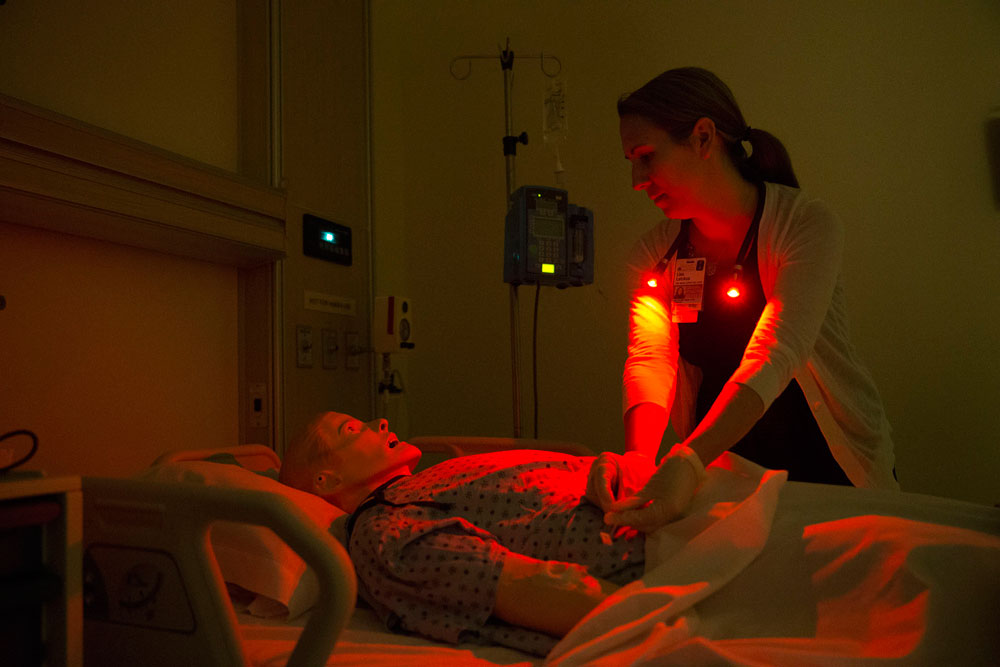Can something as simple as a colored bulb promote sleep in the hospital?


 Hospitals are full of obstacles to a good night’s sleep: bedding, noise, personal cleanliness, distressing neighbors and temperature extremes among them. Yet it’s well-documented that sleep is critical to healing, promoting renewal and the growth of red blood cells, and that light – too much of it, or exposure to it at rest and night time – also plays a role in getting that much-needed rest.
Hospitals are full of obstacles to a good night’s sleep: bedding, noise, personal cleanliness, distressing neighbors and temperature extremes among them. Yet it’s well-documented that sleep is critical to healing, promoting renewal and the growth of red blood cells, and that light – too much of it, or exposure to it at rest and night time – also plays a role in getting that much-needed rest.
Lisa Letzkus, a doctoral nursing student mentored by professor and associate dean Christine Kennedy, recently began studying a novel red light nursing intervention that she thinks may enable patients to get more shut-eye during hospitalization, a project that extends the work of her dissertation – titled “Improving Outcomes Following Pediatric Brain Injury” – which earned her the 2015 Suzi Burns Clinical Reserach Fund from the School of Nursing and U.Va. Medical Center. Letzkus' work also follows up on that of nursing professor Anita Thompson-Heisterman and the 5E nursing staff whose original research citing red light's benefits in patient care at night serves as its foundation.
Letzkus' new endeavor is based on the fact that red light, more than any other color, promotes sleep. White and yellow light, conversely, tend to rouse and stimulate – and also tend to be most commonly used in hospitals.
“While we nurses cannot completely control noise levels, improve insulation or the thickness of the walls,” Letzkus said, “we can control other environmental factors that promote healing and rest. And lighting is definitely something nurses can control.”
Letzkus – whose project earned her a one-year fellowship with the U.Va. Center for Design and Health – will study the effect of red light on sleep and sleep disturbance among adult and pediatric in-patients staying at the U.Va. Medical Center. Using Actiwatches – wrist-worn devices that record the intensity of room lighting as well as the rhythm and duration of patients’ sleep and wake cycles – Letzkus will replace regular recessed flood lights with a single red-colored bulb on one unit. On another unit, bedside nurses will wear $10 “hug lights” – necklaces which emit only low-level red and white light for quiet rounding – while caring for pediatric patients during their rest time.
Letzkus and research colleague Beth Quatrara, U.Va. Medical Center’s director of nursing research, will also interview the patients about their perceptions of sleep and the red lights as well as querying unit nurses caring for them.
Letzkus said she hopes their model of low and red light might become the standard of care at U.Va. and elsewhere, once the data are amassed to show the hypothesized positive association between sleep and low and red light. Before their full-scale study, Letzkus and Quatrara will first conduct a feasibility study with 20 adult and 20 pediatric in-patients for the two red-light interventions and assess the effectiveness of the Actiwatches.
With promising data close at hand, the duo expects to develop a larger, more robust and randomized trial in the near future, and the results may eventually change the way the Medical Center is lit, as well as the way nighttime rounds are conducted.
Dorrie Fontaine, dean of the School of Nursing and also a scholar on sleep promotion, called the Center for Design and Health fellowship – which annually sponsors cross-disciplinary research projects to advance design to promote healthy people and cities – “ true collaborative oppotunity to make meaningful change. in this case ensuring sleep promotion, by tapping experts across disciplines, from the Medical Center, the School of Architecture and the School of Nursing.”
For Letzkus, it’s also a chance to consider present conditions in patients’ rooms as well as to reconsider best practices when building hospitals and clinics.
“There needs to be really thoughtful collaborations when buildings and hospital rooms are being developed to revisit every possible scenario so that the patient receives the very best care,” she said. “We do need light options that work, but sometimes we don’t need the maximum of light, and in some things, like light, we should do with the least amount possible.”
# # #
